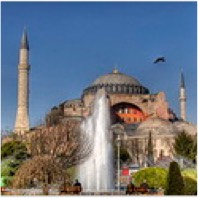Dolmabahce Palace

Dolmabahce Palace was built in 1843-1856 for Sultan Abdül Mecit. Turkey was doing very badly at the time, the sultan should have pumped money into the economy, but decided to advertise the greatness of his crumbling empire with a palace, forcing his suffering population to pick up the bill.
Here is one of the most glamorous palaces in the world. It was the administrative center of the late Ottoman Empire with the last of Ottoman Sultans was residing there. After the foundation of the Turkish Republic in Ankara, Mustafa Kemal Ataturk transferred all government functions to the youthful capital but on his visits to İstanbul. Ataturk occupied only a small room at Dolmabahce Palace as his own. He stayed, welcomed his foreign guests and made a practical center for national, historical and language congress and for international conferences.
The palace layout and decor reflect the increasing influence of European styles and standards on Ottoman culture and art during the Tanzimat period. The construction works cost five million Ottoman mecidiye gold coins, the equivalent of 35 tonnes of gold. Fourteen tonnes of gold in the form of gold leaf were used to gild. The world's largest Bohemian crystal chandelier is in the center hall. That chandelier is a gift from Queen Victoria, has 750 lamps and weighs 4.5 tonnes. Functionally, on the other hand, it retains elements of traditional Ottoman palace life, and also features of traditional Turkish homes. It is the largest palace in Turkey, considering that the area of the monoblock building occupies 45,000 m².
Dolmabahce palace has a great meaning for Turkish people since the supreme leader Mustafa Kemal Ataturk had used the palace as a residence and spent the most serious period of his illness and he passed away in this palace on 10 th of November 1938 at 9:05 AM, all the clocks in the palace are stopped at this time. Later on it was converted into a museum. It is wandered with a special sense of respect.







